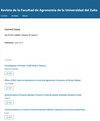Morphometric parameters and photosynthetic performance of in vitro propagated pineapple
IF 0.5
4区 农林科学
Q4 AGRONOMY
Revista De La Facultad De Agronomia De La Universidad Del Zulia
Pub Date : 2022-11-29
DOI:10.24215/16699513e098
引用次数: 0
Abstract
Pineapple (Ananas comosus) is a horticultural species of the Bromeliaceae family of high socioeconomic interest, widely cultivated around the world. The multiplication of pineapple seedlings in the field can be time-consuming, requiring a significant labor investment. The objective of this study was to evaluate the performance of continuous and temporary immersion systems in the micropropagation scale-up of the species. Shoots were obtained from explants subcultured in flasks with gelled culture medium and without gas exchange. The shoots were transferred to liquid MS medium supplemented with 2mM NAA, and 4mM BAP, and cultivated in four different devices: sealed flasks, flasks with semipermeable gas membranes, RITA®, and twin-flasks. After 45 days of cultivation, plant growth, fresh mass increment, the stomatal density of the abaxial surface of the leaves, the maximum quantum yield of the photosystem II, and contents of chlorophyll and carotenoids were analyzed. Significant differences were observed in plant growth, stomatal density, and contents of chlorophyll and carotenoids. The twin-flasks and RITA® devices revealed better results in morphological parameters, such as plant growth and stomatal density, while the treatments in sealed flasks and with membrane stood out in the chlorophyll content.凤梨离体繁殖的形态计量参数与光合性能
菠萝(Ananas comosus)是凤梨科的一种具有高度社会经济价值的园艺物种,在世界各地广泛种植。菠萝幼苗在田间繁殖可能很耗时,需要大量的劳动力投资。本研究的目的是评估连续浸泡和临时浸泡系统在该物种的微繁殖规模中的性能。外植体在无气体交换的情况下,用凝胶培养基在烧瓶中继代培养,获得嫩芽。将芽转移到添加2mM NAA和4mM BAP的MS液体培养基中,并在四种不同的设备中培养:密封烧瓶、半透膜烧瓶、RITA®和双烧瓶。培养45 d后,对植株生长、鲜质量增量、叶片背面气孔密度、光系统II最大量子产率、叶绿素和类胡萝卜素含量进行分析。在植物生长、气孔密度、叶绿素和类胡萝卜素含量方面存在显著差异。双瓶和RITA®装置在植物生长和气孔密度等形态学参数方面显示出更好的结果,而密封瓶和膜处理在叶绿素含量方面表现出更好的效果。
本文章由计算机程序翻译,如有差异,请以英文原文为准。
求助全文
约1分钟内获得全文
求助全文
来源期刊
CiteScore
0.50
自引率
0.00%
发文量
45
审稿时长
>12 weeks
期刊介绍:
La Revista de la Facultad de Agronomía de la Universidad del Zulia publica artículos científicos, notas técnicas, comunicaciones rápidas y artículos invitados originales e inéditos, es decir, que no hayan sido publicados ni enviados simultáneamente a otra revista para su publicación, de autores interesados en el campo agrícola vegetal y agrícola animal. De presentarse el caso que el autor o autores hubiesen enviado o publicado su manuscrito simultáneamente en otra revista, podrán ser sancionados con la no publicación en esta revista por tiempo indefinido.
Se admiten manuscritos escritos en idioma Español, Portugués o Inglés, con un resumen en Español o Portugués y otro en Inglés (Abstract).

 求助内容:
求助内容: 应助结果提醒方式:
应助结果提醒方式:


